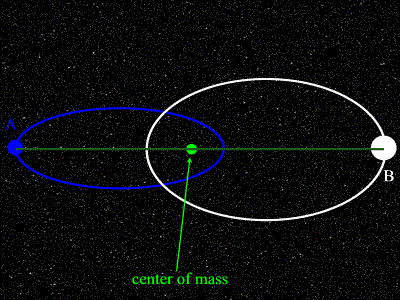Introduction
If in a clear night we elevate the look to the firmament,we will notice that some objects of punctual appearance reveal us, before the telescope, their true dual nature. These objects are called Double Stars or Binary Stars.
A binary star is a group of two stars that rotate around a common center of gravity ( center of mass ) , following the Law of Universal Gravitation that Sir Isaac Newton had formulated in 1666:

where m1 and m2 are the masses of the two stars (in kilograms), F is the force of gravity between the masses m1 and m2 , " r " is the distance that separates to both ( in meters ) , and " G " is the Constant of Universal Gravitation and it is worth G = 6.672x10-11 m3/kg1/s2.

It is said that it is a multiple system if the group is formed by three or more stars.
In the year 1650 the Italian astronomer Riccioli discovers, observing with his telescope, that the star Mizar (Zeta Ursae Majoris) it is,in fact, a double of very next stars.From that date it had been discovered thousands and thousands of these objects.
Today in day , all amateur astronomers are aware of the paper that the double star carry out in the theory of the formation and stellar evolution: from their origin, the component are interact constantly, giving to the other part of their superficial mass until, once out the nuclear fuel, one of them explodes catastrophically as supernova, leaving in their place (and according to the initial masses ) a white dwarf , a star of neutrons or a black hole.
It is known that a great percentage of the stars of the Universe belongs to such systems, and only in them it is possible to determine the fundamental physical parameter of all star, its mass directly.
The individual stars of the system are called " components ".
The systematic and continuous study of the relative position of the less brilliant component ( secondary component, B ) regarding the most brilliant component ( primary component, A ) of a binary system,it throws important results related with the form and orientation of the orbit, and , consequently , they allow to deduce such physical parameters as the mass, size , density , evolution degree, etc.
By applying Kepler's and Newton's laws to the analysis of a binary star orbits it is possible to determine the mass of stars. In fact, recall Kepler's 3rd law in Newtonian form:

where m1 and m2 are the masses of the components expressed in solar masses ( 1MSun = 1.989x1033gm), P is the orbital period in years, and R is the average orbital separation between the center of the stars in AU ( 1 AU = 1 Astronomical Unit = 149597870 km = 92955807 miles). But ( m1 + m2 ) it is the total mass of the binary system. For example, the nearest star, Alpha Centauri, located at 4.4 years light of the Sun , is a binary star (in fact it is a triple system) whose component orbit around the center of masses in 79.9 years and the distance average between this components is approximately 23.7 AU ( similar at the distance Sun-Uranus ), then we can calculate the total mass of the system ( m1 + m2 ) como 2.09 MMsun.
Several types of binary systems exist, such as:
- Optic Double Stars: the two stars are visible and they are near one to the other (in the sky) due to a perspective effect, because in fact both are very far from the Earth (at different distances) but they are almost in the same line of visual.
- Visual Double Stars: both components are visible and they can be resolved easily through a small telescope,long orbital periods (hundred of years).
- Eclipsing Double Stars: only one component is visible and the orbit is aligned exactly with regard to the Earth , in such a way that a component can hide to the other one and it happens this way an eclipse, it can see a periodic variations of the brightness (in function of the time).
- Astrometric Double Stars: it is only visible one component,the other star is detected by oscillations in the proper movement of the visible component in the sky ( regarding "fixed" stars ) , because the visible component is perturbed due to gravity of the other star.
- Spectroscopic Double Stars: it is only visible one component, they are systems that appear like a simple star but that they show variations in their spectra that can be attributed to the presence of more than one component, periodic shifting of the spectral lines.
Because the double optics don't present the smallest interest astrophysicist, these type of stars are not observed,and in function of the observation possibilities with small telescopes,the visual double are those susceptible binary systems of being measured by the amateur astronomers.
From the amateur point of view, the measurement of binary stars and multiple systems it presents certain advantages in relation to the observation of other celestial phenomenons:
- Doesn't require to be adjusted to certain observation dates.
- In any place of the celestial vault is always maximum the possibility to find one of these objects.
- The contamination for artificial illumination ( or lunar ) of the sky it doesn't hinder the work.
- To exception of a telescope, is not required to possess instrumental very sophisticated.
Let us remember that the double stars of great apparent distance, that is to say of more AS that 2" , they are not controlled neither for the professional astronomers and neither for the amateur, in spite of being accessible to telescopes of medium size ( 15 cm of objective diameter ) , specially the double of the southern celestial hemisphere. Therefore, among other reasons , we should find sufficiently justified facing a work of this nature.
